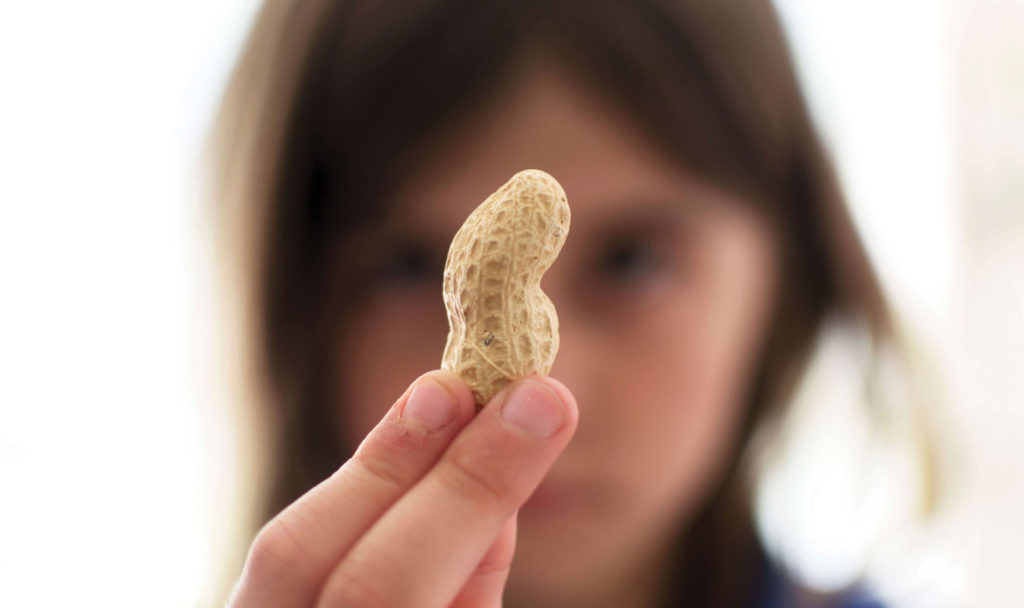Some children may outgrow their food allergies. But the likelihood of that happening depends in large part on the type of food a child is allergic to, as well as the severity of the allergy.
In people who have a food allergy, the body’s immune system mistakenly identifies a specific food or part of a food as something harmful. When that happens, the immune system releases into the body immunoglobulin E, or IgE, antibodies. The next time the IgE antibodies sense that food, they cause a variety of chemicals, including histamine, to be released into the bloodstream.
Those chemicals trigger the symptoms of the food allergy, such as hives, skin or throat swelling, gastrointestinal problems, or breathing problems. In some people, a food allergy may lead to a life-threatening reaction known as anaphylaxis. Symptoms of anaphylaxis can include the above symptoms as well as severe tightening of the airways (causing breathing problems), rapid pulse, drop in blood pressure, and/or loss of consciousness. Without emergency medical treatment including epinephrine, anaphylaxis may result in death.
Food allergies affect about 6 to 8 percent of children under age 5, and about 3 to 4 percent of adults. Food allergies often are confused with a much more common reaction known as food intolerance. While bothersome, a food intolerance often is less serious. Usually, its symptoms come on gradually and are limited to digestive problems. Testing generally is not available for food intolerance. A severe form of food intolerance called food protein-induced enterocolitis syndrome, or FPIES, should be evaluated by an allergist or gastrointestinal specialist. Most children outgrow FPIES.
It is possible to have an allergic reaction to almost any type of food. But some foods lead to allergies more frequently than others. Of the common food allergies, milk, egg, soy and wheat allergies are the ones children most often outgrow by the time they are in their late teens.
About 60 to 80 percent of young children with a milk or egg allergy are able to have those foods without a reaction by the time they reach age 16. Recent studies suggest that children with egg or milk allergies who can eat those foods in a baked form, such as a muffin, without an allergic reaction are very likely to be able to tolerate plain egg or plain milk in the future.
Some other food allergies are much less likely to be outgrown. These foods are also common allergens and include peanuts, tree nuts, finned fish and crustacea. They tend to cause a more severe food allergy reaction. Only about 20 percent of children who have a peanut allergy outgrow it. An even lower number of those with tree nut allergies — 14 percent — will lose that allergy. And only 4 to 5 percent of children with a fish or crustacean (shellfish) allergy will go on to be able to eat those foods without a reaction later in life.
In many cases a blood test or an allergy skin test, combined with a thorough assessment of a child’s health history, can help determine how likely it is for that child to outgrow his or her food allergy.
If it seems a child has outgrown a food allergy, a test called a food challenge may be recommended. It involves giving the child small amounts of the food in a controlled setting. A very small amount is given first. It is then doubled every 15 to 30 minutes until the child eats one serving size. This test is not recommended for children who are at high risk of anaphylaxis.
If your child has a food allergy, it is a good idea to work with a doctor who specializes in childhood allergies. An allergist can help you monitor and manage a food allergy over time as your child grows.
First Aid For Allergic Reactions
Reviewed By Kate M. Cronan, MD, Courtesy of KidsHealth.org
Allergic reactions can be triggered by foods, medicines, pets, insect stings, pollen, and other things. Most allergic reactions aren’t serious. But severe reactions can be life-threatening and need immediate medical care.
Signs & symptoms of an allergic reaction
Mild
itching
skin redness
slight swelling
stuffy, runny nose
sneezing
itchy, watery eyes
red bumps (hives) anywhere on the body
Severe
swelling of the mouth or tongue
trouble swallowing or speaking
wheezing or trouble breathing
belly pain, nausea, vomiting, or diarrhea
dizziness or fainting
What to Do
Contact a doctor if your child has an allergic reaction that is more than mild or concerns you.
If the symptoms are mild, give an antihistamine by mouth such as diphenhydramine (such as Benadryl).
If the symptoms are severe and you have injectable epinephrine (such as EpiPen), use it as directed right away and call 911 for emergency medical help.
Think Prevention!
Help kids avoid anything they’re allergic to, and keep an oral antihistamine available. If your child has a severe allergy or has had a severe reaction, be sure the injectable epinephrine is on-hand at all times (including at school). You, your child (if old enough), and anyone who cares for your child should know how to use it.
Posted in: Health & Nutrition
Comment Policy: All viewpoints are welcome, but comments should remain relevant. Personal attacks, profanity, and aggressive behavior are not allowed. No spam, advertising, or promoting of products/services. Please, only use your real name and limit the amount of links submitted in your comment.
You Might Also Like...

Be Well Postpartum: 7 Tips for a Healthy Postpartum Experience
Throughout your pregnancy, you eat the right foods, drink plenty of fluids, rest and try to keep stress to a minimum. You might think once your baby arrives that you […]

12 Ways to Exercise without Spending a Dime
With the holidays over and bathing suit season just a few months away, people begin to reevaluate their exercise routine. Is it time to step it up? Should you join […]

What Parents Need to Know About Concussions
As young athletes are donning their helmets and pads for fall sports practice, many parents might feel conflicted about cheering them on. This spring, the family of Tyler Hilinski, the […]

Camp Okizu: More Than Just Fun And Games
Camp Okizu expands across 500 acres at Berry Creek, 70 miles north of Sacramento, and embraces thousands of children and families every year. Four lakes, sleeping cabins and shower facilities […]




